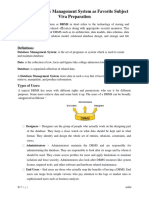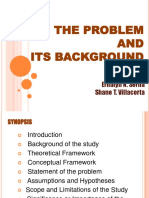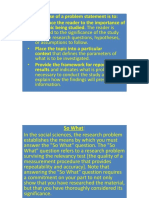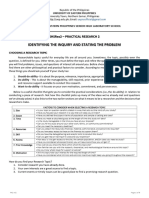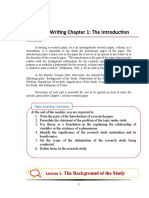0 ratings0% found this document useful (0 votes)
2 viewsL1C - Chapter 1
The document outlines strategies for writing the introductory section of a thesis, including starting with a quotation, presenting statistics, or stating the researcher's rationale. It emphasizes the importance of clearly defining the problem, the significance of the study, and the theoretical framework. Additionally, it details the structure of the introduction, including background, scope, and definitions of key terms.
Uploaded by
dot comCopyright
© © All Rights Reserved
Available Formats
Download as PDF, TXT or read online on Scribd
0 ratings0% found this document useful (0 votes)
2 viewsL1C - Chapter 1
The document outlines strategies for writing the introductory section of a thesis, including starting with a quotation, presenting statistics, or stating the researcher's rationale. It emphasizes the importance of clearly defining the problem, the significance of the study, and the theoretical framework. Additionally, it details the structure of the introduction, including background, scope, and definitions of key terms.
Uploaded by
dot comCopyright
© © All Rights Reserved
Available Formats
Download as PDF, TXT or read online on Scribd
You are on page 1/ 17
Dr. FLORANTE D. POSO, JR.
One of the initial difficulties
faced by a thesis writer is
how to start the introductory
section.
To help ease the problem,
the following approaches
are suggested.
1. Start with a brief but provocative quotation
that us applicable to the theme of the study.
2. Commence with striking facts or statistics
that objectively portray the existing
problem situation.
3. Begin by presenting a very brief background
or resume of events that truly depict the
present state of the issue abroad, in the
country and in the locality.
4. Begin with the researcher’s firm stand in the
need to bridge the gap between existing bodies
of knowledge and the prevailing problem
situation.
5. Start with the researcher’s rationale concerning
the need to replicate completed study
6. If a new theory is being envisioned for the
study, commence by attacking some pertinent
universally-held theories of psychologists,
social scientists, or experts in the subject and
giving the rationale behind the research
undertaking.
1. Presentation of the problem.
2. The existence of an unsatisfactory
condition, a felt problem that
needs a solution.
3. Rationale of the study.
4. Historical background of the
problem.
5. A desire to have a deeper and clearer
understanding of a situation,
circumstance or phenomenon.
6. A desire to find a better way of doing
something or of improving a
product.
7. A desire to discover something.
8. Geographical conditions of the study
locale.
9. A link between the introduction and
the statement of the problem.
There should be a general
problem and followed by the
specific problems into which
the general problem is broken
up.
This section discusses the importance of the
study to society, the country, the government,
the community, the institution, the agency
concerned, and the thesis writer himself. It
expounds on the study’s probable impact to
education, science, technology, on-going
researches, etc. It also gives the justification for
the study in terms of its contribution to theory
and practice. Lastly, it touches on the
significance of the study to the researcher
himself, what it does to his profession, and the
difference it makes to his own professional
growth.
The rationale, timeliness and/or relevance of
the study.
Possible solutions to existing problems or
improvement to unsatisfactory conditions.
Who are to be benefited and how they are
going to be benefited.
Possible contribution to the fund of
knowledge.
Possible implications
Explained in this section is the
nature, coverage, and time frame of
the study. It presents in brief the
subject areas of investigation, the
number of respondents or subjects
involved, the place, the time period
or school year covered, and the
rationale behind delimiting the scope
of the study.
A brief statement of the general purpose of
the study.
The subject matter and topics studied and
discussed.
The locale of the study, where the data were
gathered or the entity to which the data
belong.
The population or universe from which the
respondents were selected.
The period of the study.
A theoretical framework is a conceptual
model that:
• Defines key concepts, variables, and their
relationships within a study.
• Serves as a roadmap for developing arguments in
research.
• Outlines relationships between variables,
assumptions, and theories.
• Compiles research findings to explain connected
concepts.
From the review of related literature and
studies, the researcher may formulate a
theoretical scheme for his research problem.
This scheme is tentative explanation or
theoretical explanation of the phenomenon or
problem and serves as the basis for the
formulation of research hypotheses.
The conceptual framework consists of the
investigator’s own position on a problem
after his exposure to various theories that
have bearing on the problem.
Aparadigm is a diagrammatic
representation of a conceptual
framework. It depicts in a
more vivid way what the
conceptual framework wants
to convey.
INPUT – PROCESS - OUTPUT
Under this main topical
component are the operational
and conceptual definitions of
the terms that are found in the
title of the study, including
other unusual and technical
terms.
1.1. Background of the Study
1.2 Significance of the Study
1.3 Statement of the Problem
1.4 Scope and Limitations
1.5 Theoretical Framework
1.6 Conceptual Framework
1.7 Definition of Terms
You might also like
- Lesson 4: Practical Research 2 Aclc College of Tacloban Shs DepartmentNo ratings yetLesson 4: Practical Research 2 Aclc College of Tacloban Shs Department12 pages
- Introduction and Background of The StudyNo ratings yetIntroduction and Background of The Study46 pages
- COMPILED READINGS AND GUIDELINES ON HOW TO WRITE THESIS (Prof. Zahiya B. Hadji Salih)No ratings yetCOMPILED READINGS AND GUIDELINES ON HOW TO WRITE THESIS (Prof. Zahiya B. Hadji Salih)13 pages
- Qtr3week2identifying The Problem and Asking The Questions100% (1)Qtr3week2identifying The Problem and Asking The Questions47 pages
- Designing a Research Project Related to Daily LifeNo ratings yetDesigning a Research Project Related to Daily Life8 pages
- Identifying the Problem and Asking the QuestionNo ratings yetIdentifying the Problem and Asking the Question40 pages
- 4th Yeas-2022 - Research Methods Capter 1-4No ratings yet4th Yeas-2022 - Research Methods Capter 1-485 pages
- Writing The Introduction: Agric. 206 (Methods of Agricultural Research)No ratings yetWriting The Introduction: Agric. 206 (Methods of Agricultural Research)10 pages
- Defining Research Problem and Hypothesis FormulationNo ratings yetDefining Research Problem and Hypothesis Formulation31 pages
- FORMULATION OF PROBLEM STATEMENT AND RESEARCH OBJECTIVES copyNo ratings yetFORMULATION OF PROBLEM STATEMENT AND RESEARCH OBJECTIVES copy13 pages
- Module 3 - Writing Chapter 1 - February - 24 - 2021No ratings yetModule 3 - Writing Chapter 1 - February - 24 - 202118 pages
- LAS III 12 MELC 2 Week 2-For-DistributionNo ratings yetLAS III 12 MELC 2 Week 2-For-Distribution10 pages
- Writing Research Proposal: BY Dr. Robert MugabeNo ratings yetWriting Research Proposal: BY Dr. Robert Mugabe49 pages
- Research Proposal a Simplified Step-by-Step Guide - Revised EditionFrom EverandResearch Proposal a Simplified Step-by-Step Guide - Revised EditionNo ratings yet
- Reliability Analysis of the Rolling Stock Industry_ A Case StudyNo ratings yetReliability Analysis of the Rolling Stock Industry_ A Case Study9 pages
- For (Var Startvalue Var Endvalue Var Var+increment) (Code To Be ExecutedNo ratings yetFor (Var Startvalue Var Endvalue Var Var+increment) (Code To Be Executed8 pages
- The Pythagorean Theorem and Its Converse: VocabularyNo ratings yetThe Pythagorean Theorem and Its Converse: Vocabulary24 pages
- zCEE Customization Security and CICS PDFNo ratings yetzCEE Customization Security and CICS PDF26 pages
- Religion Compass Volume 1 Issue 6 2007 (Doi 10.1111/j.1749-8171.2007.00043.x) Ann Jeffers - Magic and Divination in Ancient IsraelNo ratings yetReligion Compass Volume 1 Issue 6 2007 (Doi 10.1111/j.1749-8171.2007.00043.x) Ann Jeffers - Magic and Divination in Ancient Israel15 pages
- Hud Hudson - Fallenness and Flourishing-Oxford University Press (2021)No ratings yetHud Hudson - Fallenness and Flourishing-Oxford University Press (2021)232 pages
- Assignment Set - 1: 1. Explain Briefly The Characteristics of CommunicationNo ratings yetAssignment Set - 1: 1. Explain Briefly The Characteristics of Communication12 pages
- Describe The Shooting of The Elephant by George Orwell in Your Own WordsNo ratings yetDescribe The Shooting of The Elephant by George Orwell in Your Own Words4 pages
- Two-Column Template For Conference Proceedings Based On IEEE Format (Title)No ratings yetTwo-Column Template For Conference Proceedings Based On IEEE Format (Title)3 pages
- The Societies and The Ethical Values in Beowulf and Sir Gawain and The Green KnightNo ratings yetThe Societies and The Ethical Values in Beowulf and Sir Gawain and The Green Knight9 pages
- Father+of+Spirits+Lyrics+by+Theophilus+Sunday+%7C+African+Gospel+Lyrics_1736804420460No ratings yetFather+of+Spirits+Lyrics+by+Theophilus+Sunday+%7C+African+Gospel+Lyrics_17368044204606 pages
- RAID (Redundant Array of Independent Disks)No ratings yetRAID (Redundant Array of Independent Disks)16 pages
- How To Configure Electronic Bank Statements in SAPNo ratings yetHow To Configure Electronic Bank Statements in SAP3 pages
- Lenovo Intelligent Computing Orchestration (Lico) : Product GuideNo ratings yetLenovo Intelligent Computing Orchestration (Lico) : Product Guide25 pages
- BAdI Determination of Alert Manager ClassNo ratings yetBAdI Determination of Alert Manager Class2 pages
- Discuss The Following Operating Systems Structures of Stating Advantages and Disadvantages If AnyNo ratings yetDiscuss The Following Operating Systems Structures of Stating Advantages and Disadvantages If Any4 pages
- Precalculus mathematics for calculus student solutions manual 6th edition Edition Bulman-Fleming all chapter instant download100% (1)Precalculus mathematics for calculus student solutions manual 6th edition Edition Bulman-Fleming all chapter instant download67 pages
- Research Methodology for Social Sciences: An OverviewFrom EverandResearch Methodology for Social Sciences: An Overview
- Lesson 4: Practical Research 2 Aclc College of Tacloban Shs DepartmentLesson 4: Practical Research 2 Aclc College of Tacloban Shs Department
- COMPILED READINGS AND GUIDELINES ON HOW TO WRITE THESIS (Prof. Zahiya B. Hadji Salih)COMPILED READINGS AND GUIDELINES ON HOW TO WRITE THESIS (Prof. Zahiya B. Hadji Salih)
- Qtr3week2identifying The Problem and Asking The QuestionsQtr3week2identifying The Problem and Asking The Questions
- Designing a Research Project Related to Daily LifeDesigning a Research Project Related to Daily Life
- Writing The Introduction: Agric. 206 (Methods of Agricultural Research)Writing The Introduction: Agric. 206 (Methods of Agricultural Research)
- Defining Research Problem and Hypothesis FormulationDefining Research Problem and Hypothesis Formulation
- FORMULATION OF PROBLEM STATEMENT AND RESEARCH OBJECTIVES copyFORMULATION OF PROBLEM STATEMENT AND RESEARCH OBJECTIVES copy
- Module 3 - Writing Chapter 1 - February - 24 - 2021Module 3 - Writing Chapter 1 - February - 24 - 2021
- Research Proposal a Simplified Step-by-Step Guide - Revised EditionFrom EverandResearch Proposal a Simplified Step-by-Step Guide - Revised Edition
- Reliability Analysis of the Rolling Stock Industry_ A Case StudyReliability Analysis of the Rolling Stock Industry_ A Case Study
- For (Var Startvalue Var Endvalue Var Var+increment) (Code To Be ExecutedFor (Var Startvalue Var Endvalue Var Var+increment) (Code To Be Executed
- The Pythagorean Theorem and Its Converse: VocabularyThe Pythagorean Theorem and Its Converse: Vocabulary
- Religion Compass Volume 1 Issue 6 2007 (Doi 10.1111/j.1749-8171.2007.00043.x) Ann Jeffers - Magic and Divination in Ancient IsraelReligion Compass Volume 1 Issue 6 2007 (Doi 10.1111/j.1749-8171.2007.00043.x) Ann Jeffers - Magic and Divination in Ancient Israel
- Hud Hudson - Fallenness and Flourishing-Oxford University Press (2021)Hud Hudson - Fallenness and Flourishing-Oxford University Press (2021)
- Assignment Set - 1: 1. Explain Briefly The Characteristics of CommunicationAssignment Set - 1: 1. Explain Briefly The Characteristics of Communication
- Describe The Shooting of The Elephant by George Orwell in Your Own WordsDescribe The Shooting of The Elephant by George Orwell in Your Own Words
- Two-Column Template For Conference Proceedings Based On IEEE Format (Title)Two-Column Template For Conference Proceedings Based On IEEE Format (Title)
- The Societies and The Ethical Values in Beowulf and Sir Gawain and The Green KnightThe Societies and The Ethical Values in Beowulf and Sir Gawain and The Green Knight
- Father+of+Spirits+Lyrics+by+Theophilus+Sunday+%7C+African+Gospel+Lyrics_1736804420460Father+of+Spirits+Lyrics+by+Theophilus+Sunday+%7C+African+Gospel+Lyrics_1736804420460
- How To Configure Electronic Bank Statements in SAPHow To Configure Electronic Bank Statements in SAP
- Lenovo Intelligent Computing Orchestration (Lico) : Product GuideLenovo Intelligent Computing Orchestration (Lico) : Product Guide
- Discuss The Following Operating Systems Structures of Stating Advantages and Disadvantages If AnyDiscuss The Following Operating Systems Structures of Stating Advantages and Disadvantages If Any
- Precalculus mathematics for calculus student solutions manual 6th edition Edition Bulman-Fleming all chapter instant downloadPrecalculus mathematics for calculus student solutions manual 6th edition Edition Bulman-Fleming all chapter instant download

